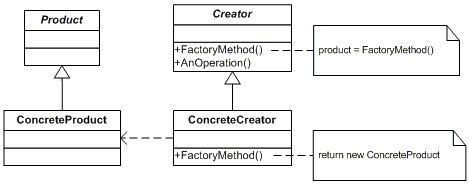Factory Method
- Intent: Define an interface for creating an object, but let subclasses decide which class to instantiate. Factory Method lets a class defer instantiation to subclasses.
- Also known as “Virtual Constructor”.
- Use the Factory Method pattern when:
- a class can’t anticipate the class of objects it must create.
- a class wants its subclasses to specify the objects it creates.
- classes delegate responsibility to one of several helper subclasses, and you want to localize the knowledge of which helper subclass is the delegate.
General Structure

Example
Participants in the example code:
- Product: Animal
- ConcreteProduct: Dog, Cat
- Creator: AnimalShelter
- ConcreteCreator: DogShelter, CatShelter
Pros/Cons
Pros ❤️
- Single Responsibility Principle - Product creation code is in the factory, the rest of the application doesn’t need to worry about it.
- Open/Closed Principle - Allows introducing new types of products into the application without breaking existing client code.
Cons 💔
- Clients might have to subclass the Creator class just to create a particular ConcreteProduct object. Subclassing is fine when the client has to subclass the Creator class anyway, but otherwise the client now must deal with another point of evolution.